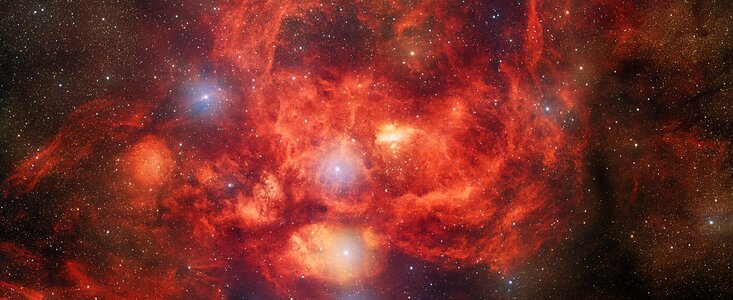Dark Energy Camera Captures Bright, Young Stars Blazing Inside Glowing Nebula
The Dark Energy Camera (DECam) mounted on the Víctor M. Blanco 4-meter Telescope at Cerro Tololo Inter-American Observatory in Chile, a Program of NSF’s NOIRLab, is celebrating 10 years as one of the highest-performance, wide-field CCD imagers in the world.
To help commemorate DECam’s first decade of operation, NOIRLab has released a breathtaking image of the star-forming Lobster Nebula (NGC 6357), which is located about 8000 light-years from Earth in the direction of the constellation Scorpius. This image reveals bright, young stars surrounded by billowing clouds of dust and gas.
At the center of the nebula, which spans about 400 light-years, resides the open star cluster Pismis 24 — a collection of dazzlingly bright, massive stars. Surrounding this cluster is a region brimming with newborn stars, protostars still wrapped in their cocoons of star-forming material, and dense cores of gas and dust that will eventually become new stars. The twisting braids of dark clouds and complex structures inside the nebula are formed by the tumultuous pressure of interstellar winds, radiation, and powerful magnetic fields.
One of the most striking things about this image is the beautifully detailed color palette selected to highlight different aspects of the nebula. This wide-field, high-resolution image showcases the power of DECam and its ability to produce stunning images while helping astronomers study the fundamental properties of the Universe.
This image was constructed using some of a new range of very special DECam narrowband filters, which isolate very specific wavelengths of light. They make it possible to infer the physics of distant objects, including important details about their inner motions, temperatures, and complex chemistry, which is especially important when examining star-forming regions like the Lobster Nebula.
In order to create a colorful image such as this one, the same celestial object is observed multiple times using different filters. Each observation provides a single-color image, which encompases a specific range of light waves. Imaging specialists then take these individual images and assign a corresponding color to each of them. The images can then be stacked on top of one another to create a composite that closely approximates what objects might look like if they were far brighter.
The image was unveiled at the DECam at 10 years: Looking Back, Looking Forward conference, which highlighted the outstanding DECam science results of the past 10 years and the exciting opportunities with DECam as astronomy looks to the future with Vera C. Rubin Observatory, currently under construction on Cerro Pachón in Chile. DECam has just passed the remarkable milestone of taking one million individual exposures, delivering on average 400 to 500 images per night.
DECam was operated by the DOE and NSF between 2013 and 2019. DECam was funded by the DOE and was built and tested at DOE's Fermilab. Currently, DECam is used for programs covering a huge range of science.
The text & image was obtained by NOIRLab’s Communication, Education & Engagement team as part of the NOIRLab Legacy Imaging Program.

